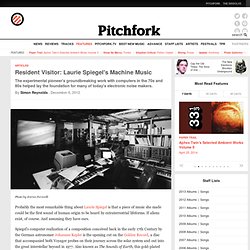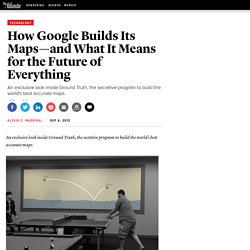

27 Science Fictions That Became Science Facts In 2012. We may never have our flying cars, but the future is here.

From creating fully functioning artificial leaves to hacking the human brain, science made a lot of breakthroughs this year. 1. Quadriplegic Uses Her Mind to Control Her Robotic Arm. Hacking / Hacken. D'ingénieur//ThinkTank. Evgeny Morozov: The IGod: Steve Jobs’s Pursuit Of Perfection—and The Consequences. Steve Jobs’s pursuit of perfection—and the consequences.

Steve Jobs By Walter Isaacson (Simon & Schuster, 627 pp., $35) In 2010, Der Spiegel published a glowing profile of Steve Jobs, then at the helm of Apple. Jobs’s products are venerated in Germany, especially by young bohemian types. How Much Tech Can One City Take? Last year, when Mayor Ed Lee heard that Twitter was planning to move its headquarters out of San Francisco and down to the peninsula, he quickly consulted with his digital experts —his two daughters, Brianna, 27, and Tania, 30. Articles: Resident Visitor: Laurie Spiegel's Machine Music. Photo by Enrico Ferorelli Probably the most remarkable thing about Laurie Spiegel is that a piece of music she made could be the first sound of human origin to be heard by extraterrestrial lifeforms.

If aliens exist, of course. And assuming they have ears. Spiegel's computer realization of a composition conceived back in the early 17th Century by the German astronomer Johannes Kepler is the opening cut on the Golden Record, a disc that accompanied both Voyager probes on their journey across the solar system and out into the great interstellar beyond in 1977.
Also known as The Sounds of Earth, this gold-plated copper record (the assumption seems to have been that any civilization advanced enough to pluck a passing probe out of space would also be able to build a turntable to play it on) includes 90 minutes of music, greetings in many languages, animal sounds, and the EEG brainwaves of a young woman in love. Spiegel recalls the moment she first learned her music was going into space. The Amazon Effect. From the start, Jeff Bezos wanted to “get big fast.”

He was never a “small is beautiful” kind of guy. The Brobdingnagian numbers tell much of the story. In 1994, four years after the first Internet browser was created, Bezos stumbled upon a startling statistic: the Internet had been growing at the rate of 2,300 percent annually. In 1995, the year Bezos, then 31, started Amazon, just 16 million people used the Internet. A year later, the number was 36 million, a figure that would multiply at a furious rate. We Recommend In Germany, fixed-price laws curtail the power of retail chains and help to sustain a vibrant literary culture. Why does Amazon now have customers do the search chores it used to do for them, and in innovative ways? About the Author Steve Wasserman Steve Wasserman, former editor of the Los Angeles Times Book Review, served as editorial director of Times Books and... The 'Busy' Trap. Anxiety: We worry.

A gallery of contributors count the ways. If you live in America in the 21st century you’ve probably had to listen to a lot of people tell you how busy they are. It’s become the default response when you ask anyone how they’re doing: “Busy!” “So busy.” “Crazy busy.” It’s not as if any of us wants to live like this; it’s something we collectively force one another to do. Notice it isn’t generally people pulling back-to-back shifts in the I.C.U. or commuting by bus to three minimum-wage jobs who tell you how busy they are; what those people are is not busy but tired. Brecht Vandenbroucke Even children are busy now, scheduled down to the half-hour with classes and extracurricular activities. Inside the U.S. Military’s Chemical-Weapons Tests. Colonel James S.

Ketchum dreamed of war without killing. He joined the Army in 1956 and left it in 1976, and in that time he did not fight in Vietnam; he did not invade the Bay of Pigs; he did not guard Western Europe with tanks, or help build nuclear launch sites beneath the Arctic ice. Instead, he became the military’s leading expert in a secret Cold War experiment: to fight enemies with clouds of psychochemicals that temporarily incapacitate the mind—causing, in the words of one ranking officer, a “selective malfunctioning of the human machine.”
How Google Builds Its Maps—and What It Means for the Future of Everything - Alexis C. Madrigal. An exclusive look inside Ground Truth, the secretive program to build the world's best accurate maps.

Behind every Google Map, there is a much more complex map that's the key to your queries but hidden from your view. The deep map contains the logic of places: their no-left-turns and freeway on-ramps, speed limits and traffic conditions. This is the data that you're drawing from when you ask Google to navigate you from point A to point B -- and last week, Google showed me the internal map and demonstrated how it was built. No Pulse: How Doctors Reinvented The Human Heart.